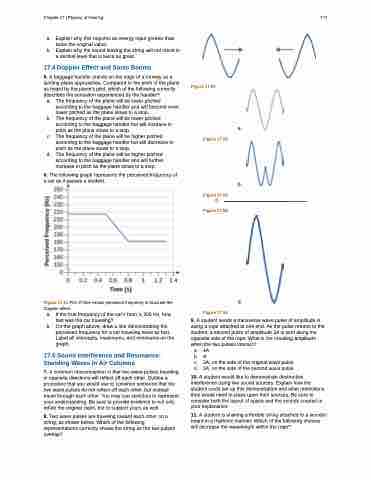Page 789 - College Physics For AP Courses
P. 789
Chapter 17 | Physics of Hearing
777
a. Explain why this requires an energy input greater than twice the original value.
b. Explain why the sound leaving the string will not result in a decibel level that is twice as great.
17.4 Doppler Effect and Sonic Booms
5. A baggage handler stands on the edge of a runway as a landing plane approaches. Compared to the pitch of the plane as heard by the plane’s pilot, which of the following correctly describes the sensation experienced by the handler?
a. The frequency of the plane will be lower pitched according to the baggage handler and will become even lower pitched as the plane slows to a stop.
b. The frequency of the plane will be lower pitched according to the baggage handler but will increase in pitch as the plane slows to a stop.
c. The frequency of the plane will be higher pitched according to the baggage handler but will decrease in pitch as the plane slows to a stop.
d. The frequency of the plane will be higher pitched according to the baggage handler and will further increase in pitch as the plane slows to a stop.
6. The following graph represents the perceived frequency of a car as it passes a student.
Figure 17.51 Plot of time versus perceived frequency to illustrate the Doppler effect.
a. If the true frequency of the car’s horn is 200 Hz, how fast was the car traveling?
b. On the graph above, draw a line demonstrating the perceived frequency for a car traveling twice as fast. Label all intercepts, maximums, and minimums on the graph.
17.5 Sound Interference and Resonance: Standing Waves in Air Columns
7. A common misconception is that two wave pulses traveling in opposite directions will reflect off each other. Outline a procedure that you would use to convince someone that the two wave pulses do not reflect off each other, but instead travel through each other. You may use sketches to represent your understanding. Be sure to provide evidence to not only refute the original claim, but to support yours as well.
8. Two wave pulses are traveling toward each other on a string, as shown below. Which of the following representations correctly shows the string as the two pulses overlap?
Figure 17.52
a.
b.
d.
9. A student sends a transverse wave pulse of amplitude A along a rope attached at one end. As the pulse returns to the student, a second pulse of amplitude 3A is sent along the opposite side of the rope. What is the resulting amplitude when the two pulses interact?
a. 4A
b. A
c. 2A, on the side of the original wave pulse d. 2A, on the side of the second wave pulse
10. A student would like to demonstrate destructive interference using two sound sources. Explain how the student could set up this demonstration and what restrictions they would need to place upon their sources. Be sure to consider both the layout of space and the sounds created in your explanation.
11. A student is shaking a flexible string attached to a wooden board in a rhythmic manner. Which of the following choices will decrease the wavelength within the rope?
Figure 17.53
Figure 17.54
c.
Figure 17.55
Figure 17.56


